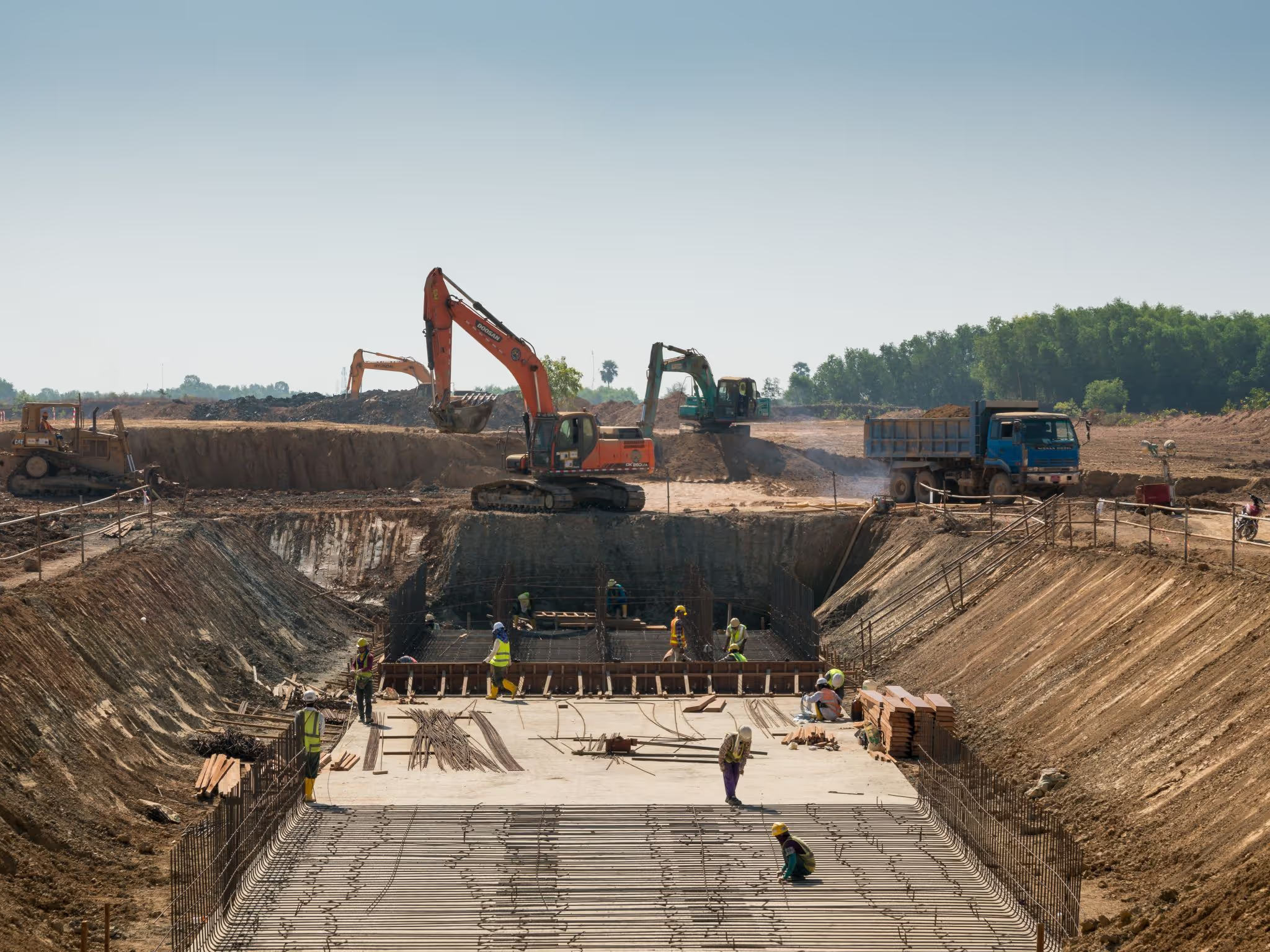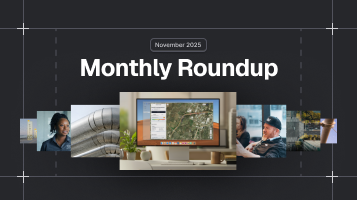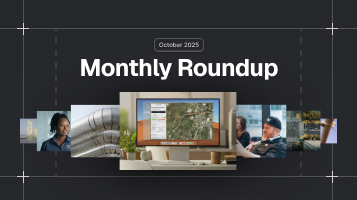10 Common Excavation Hazards
Written by
.avif)
Chris Garafola
Published on
December 12, 2023


Table of contents
Excavation work is an essential part of many construction projects, but it comes with its fair share of risks and hazards.
Case in point: in 2022, 39 people died while doing trenching and excavation work in the U.S.
To ensure the safety of workers and prevent accidents on the job, it's crucial to understand the potential dangers, ensure compliance with federal regulations, and mitigate risks. In this article, we'll look at ten common hazards associated with excavations and discuss the necessary safety measures to minimize risks.
Use the links below to jump to what you need:
- Cave-ins and collapses
- Falling objects
- Hazardous atmospheres
- Underground utilities
- Equipment accidents
- Soil stability and slides
- Engulfment and entrapment
- Weather conditions
- Unmarked utility lines
- Nearby traffic and public access
What are the top 10 trenching and excavation safety hazards?
1. Cave-ins and collapses
One of the most significant hazards in excavation work is the risk of cave-ins and collapses. Trenches can quickly become unstable, leading to the collapse of the surrounding soil. This can result in severe injuries or even fatalities for workers inside the trench. A trench collapse in Jarrell, Texas, in 2022 resulted in two deaths.
To protect against cave-ins, workers must utilize preventive measures such as a trench box—also known as a trench shield—a two-sided support system that provides stability and keeps utility workers safe while digging.
For deeper trenches, a shoring system where piles and laggings are installed at regular intervals helps to reinforce trench walls and safeguard workers.
2. Falling objects
Another common hazard in excavation sites is the risk of falling objects. Tools, equipment, or even soil can accidentally fall into the trench, posing a danger to workers below.
To prevent falling objects, it's crucial to establish barricades around the excavation area and secure tools and equipment properly. This helps create a safe work zone and reduces the risk of objects falling into the trench. OSHA regulations require keeping materials that could pose a risk at least 2 feet from the edge of the trench or use a retaining device to keep it from falling or rolling into the excavation.
3. Hazardous atmospheres
Excavations in confined spaces can be particularly dangerous due to the presence of hazardous atmospheres. Toxic gases or a lack of oxygen can accumulate in these spaces, posing a serious threat to workers.
Proper ventilation and gas monitoring are essential to ensure a safe working environment. To mitigate risks, OSHA requires atmospheric testing before workers enter an excavation area that's more than 4 feet deep where an oxygen deficiency or hazardous atmosphere is suspected. If the results show a hazardous environment, employers must provide workers with respiratory protection or work to ventilate the work site. It's also essential to keep lifesaving equipment such as safety harnesses and breathing equipment at hand in case of an emergency.
4. Underground utilities
Accidentally striking underground utilities such as gas, water, or electricity lines is another significant hazard in excavation work. Damaging these lines can lead to gas leaks, electrical shocks, localized flooding, or water contamination.
Before starting any excavation project, project leaders must ensure that the area's utilities are located, mapped, and marked. This helps workers avoid accidental strikes and ensures the safety of both the workers and the surrounding infrastructure.
5. Equipment accidents
The heavy machinery used in excavation work can pose a significant risk if it's not operated properly. According to OSHA, 75 percent of struck-by fatalities involve heavy equipment such as trucks or cranes.
To prevent equipment accidents, employers must provide proper training to equipment operators and ensure they are familiar with the specific machinery being used. Teams must also maintain clear work zones and implement safety protocols—including all OSHA regulations—to minimize the risk of accidents.
6. Soil stability and slides
Unstable soil conditions can lead to soil slides and collapses, posing a danger to workers in excavations. Factors such as soil composition, moisture content, and slope angles can contribute to soil instability. A lack of groundwater control can also pose a problem as the water erodes soil.
To assess soil stability, it's imperative to test the soil before starting any excavation project. These tests should seek to understand details such as the compressibility and permeability of the soil. When you understand the soil properties, you can better determine appropriate slope angles and implement successful retaining structures to prevent soil slides and collapses.
7. Engulfment and entrapment
When a collapse happens, or there's a significant shift of materials, workers risk being trapped or engulfed by soil or materials. Even when you implement every available safety measure, a collapse remains a possibility—so it's crucial to have trench rescue procedures and protocols in place.
Talk to workers regularly about what to do if there's an accident—and how to spot an impending collapse before it happens. Regular safety drills and inspections help workers maintain preparedness and prevent accidents. OSHA recommends establishing an injury and illness prevention program that trains workers to identify hazards and work to prevent and control them.
8. Weather conditions
No one can control the weather—but the weather can control your excavation project. Adverse weather conditions such as rain, snow, and sub-freezing temperatures can increase the risks associated with excavations.
Monitoring weather forecasts and taking appropriate precautions, such as pausing work during inclement weather, implementing drainage systems, and using protective coverings, can help mitigate the effects of adverse weather on excavation sites.
9. Unmarked utility lines
Unmarked or abandoned utility lines are a hidden hazard for excavation projects. An unexpected discovery could cause an accident or disrupt essential services. Failure to identify and avoid these lines can result in gas leaks, water main breaks, or electrical outages.
When you start with utility mapping, you can communicate with utility companies and ensure that all possible utilities are located and marked before you start your project. This helps prevent damage to unmarked utilities and ensures the safety of workers and the surrounding infrastructure.
10. Nearby traffic and public access
Excavation sites located near traffic or public areas often pose additional hazards because the proximity of vehicles and pedestrians increases the risk of accidents and injuries.
Implementing traffic control measures, such as barricades, signage, and flaggers, can help you manage the flow of traffic and ensure the safety of workers and the public. Restricting public access to excavation sites can also minimize the risk of accidents.
Inadequate Safety Precautions
Addressing excavation hazards requires a comprehensive approach to safety. Inadequate safety precautions, such as lack of safety training, inadequate personal protective equipment (PPE), and insufficient site inspections, can increase the risk of accidents and injuries.
Promoting Safe Excavation Practices
To make sure your workers stay safe:
- Provide regular safety training and drills to ensure they recognize hazards and know how to respond in an emergency.
- Provide appropriate PPE such as hard hats, safety glasses, and high-visibility vests.
- Schedule regular site inspections to identify and address any safety issues promptly.
- Comply with all OSHA regulations to minimize the risk of accidents.
When you prioritize awareness, training, and proper safety protocols, you can carry out projects with minimal risks—effectively mitigating the dangers posed by excavations.
Recent blog posts

Our Newsletter
Join 7k infrastructure professionals
Get monthly insights on ways to build smarter, faster and safer with Utility AI.






